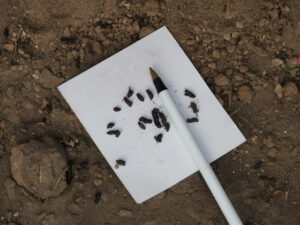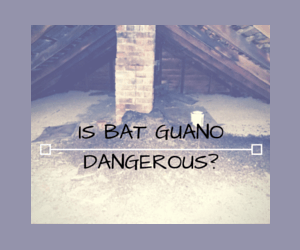How to Identify Bat Droppings
Bat droppings, also known as guano, can look similar to mouse droppings, but there are a few key differences:
Size and Shape: Guano is typically dark, elongated, and about the size of a grain of rice. However, it can also be segmented or twisted.
Location:
 Bat droppings are often found in piles directly beneath a roost, such as in an attic, within walls, or on the ground below an entryway. Mouse droppings, in contrast, are usually scattered.
Bat droppings are often found in piles directly beneath a roost, such as in an attic, within walls, or on the ground below an entryway. Mouse droppings, in contrast, are usually scattered.
The “Crumble Test”: This is the most reliable way to differentiate between the two. Bat guano is made up of the indigestible remains of insects. As a result, when you crush a dried dropping with a piece of tissue, it will easily crumble into a fine, dusty powder and may even have shiny, glittery specks from insect wings and exoskeletons. Mouse droppings, on the other hand, are harder and will not crumble in the same way.
Hazards of Bat Droppings
The primary health risk associated with bat guano is histoplasmosis, a respiratory disease caused by a fungus
(Histoplasmacapsulatum) that grows in the nutrient-rich droppings.
How it’s transmitted: The fungus releases airb orne spores when dried guano is disturbed. People can get infected by inhaling these spores.
orne spores when dried guano is disturbed. People can get infected by inhaling these spores.
Symptoms: Most people who are exposed to the fungus will not get sick or will have very mild, flu-like symptoms. However, histoplasmosis can be serious, especially for infants, the elderly, and individuals with weakened immune systems or pre-existing lung conditions. In severe cases, it can lead to pneumonia, breathing problems, and affect other parts of the body.
Other risks: While less common, accumulations of bat guano can also provide a breeding ground for other harmful microorganisms and arthropods like mites and fleas that can then enter your home. The sheer weight of a large, long-term accumulation of guano and crystallized urine can also stain and even compromise a building’s structure.
Important Precautions:
Do not disturb the droppings: The risk of histoplasmosis is very low for small, scattered droppings. The danger increases when large accumulations are disturbed, causing the fungal spores to become airborne.
Wear protective gear: If you must handle bat droppings, wear a properly fitted dust mask (particulate respirator) and disposable gloves to avoid inhaling spores or coming into direct contact with the guano.
Consider professional help: For large-scale cleanups, it is highly recommended to contact a professional wildlife control or remediation service. They have the appropriate equipment and expertise to safely remove bats and clean up guano, minimizing the risk of exposure to you and your family.
